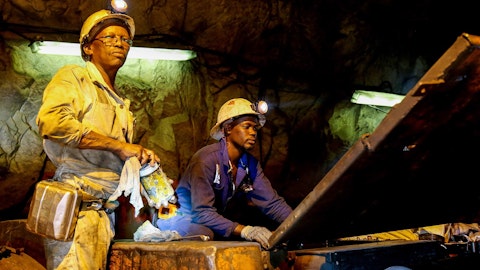Jugal Vijayvargiya: Yeah, so, as we indicated, we would be looking at starting to slow down, certainly not stopping production. So the incremental capacity is absolutely something that I think is very usable because it’s capacity that we were using right prior to starting this program. And so we will simply shift that capacity to other activities in the commercial sector or consumer sector or the automotive sector. So we will make sure that that capacity is being utilized appropriately. If for some reason we have issues with that, we’ll take appropriate action to adjust the cost structure.
Operator: Your next question is coming from Mike Harrison from Seaport Research Partners. Mike, your line is live. You may proceed.
Mike Harrison: Hi. Good morning. Was wondering, appreciate all the detail you provided on the semi outlook, but just was hoping that you maybe we can focus on the performance, in the first quarter, particularly on the margin side. I know you called out the nice year-on-year improvement, but I think what was more interesting was the improvement sequentially on essentially the same level of value added sales. Can you talk about what led the margin to be so much better in Q1 than it was in Q4, even though that value added sales level was pretty similar?
Jugal Vijayvargiya: Yeah, let me start with that and then certainly Shelley can add to that. As you know, EM has been a focused area for us for margin improvement, right. We have talked about how we need all of our businesses to contribute so that the overall company is able to get to 20% EBITDA margins or better. As the semi decline started to happen and I’m going to go back to probably Q1 of last year, right, Q1 was almost kind of a peak quarter for us in sales. Our margins started to frankly, get impacted. We started to make significant cost improvement initiatives starting in the second quarter, but more importantly, I would say in the back half of the year and as you know, sometimes, as you’re making those plant improvements and operational improvements, they take a little bit of time to get into play and so, we’re starting to see the benefits of that.
And so I’m really, really proud of, I think what the team has been able to do and to drive that improvement, I would expect that some of these improvements are going to continue, and I can assure you we’re not going to back off on that. Some of these improvements are going to continue and we’re going to hopefully be able to drive margin enhancement, as the market recovery happens. So that’s a big part of it. Now, certainly there’s always, sometimes there’s a little bit of one time issues or sometimes there’s a little bit of mix issues. Those things go back and forth every quarter. But I think fundamentally, it’s really the core improvements and the operational improvements that our teams have been driving over the last six, nine months that are starting to bear fruit and starting to deliver here in Q1 and I would expect that we continue to keep a focus on that.
We need our EM business to deliver and contribute towards the 20% objective of EBITDA margins that we have.
Mike Harrison: All right, thank you for that and then was also wondering if you can lay out where we are in this inventory corruption that’s going on in the industrial business, these beryllium nickel springs, I believe, for commercial sprinkler systems. Can you just kind of help us understand, we’ve seen destocking in a lot of different pockets of the economy, but this seems to be one that kind of cropped up later and just curious if you feel like things are improving or if it’s going to be something that’s weak for the remainder of the year?
Jugal Vijayvargiya: Yeah, this is one that is a kind of a fairly unique product, right, in the industrial sector and it’s hard to correlate it to a PMI index or some other type of an index, right. That’s kind of a unique product and used for this non-residential construction. We are obviously the provider of these for the market. There was a significant growth that happened coming out of COVID and I think the channel, frankly, got a little flushed with the inventory. As the interest rates and some of the inflation activities and some of the just the general downturn, I think that we all know that that’s happening in the overall commercial construction and occupancy. As a result of that, we are just going through that inventory correction.
It started to happen late last year. So maybe let’s say in Q4, but I would expect that the first half of this year is going to be a meaningful inventory correction that’s going to happen in this business and we would expect to start picking back up in the back half of the year, but I would expect the pickup to be, let’s say a slight, but then more meaningful pickup in ’25 as that inventory is worked through. So again, I want to emphasize, I think, that this is not a share loss issue. This is simply just a inventory correction on a more specific element of what we consider in the industrial sector and we would expect a small turnaround in the back half, but then a meaningful turnaround in ’25.
Mike Harrison: All right, very helpful. And then last question for me is just with your balance sheet, you mentioned just below the midpoint of your target leverage range. Curious if you can give us an update on your acquisition pipeline, what you’re seeing in the M&A marketplace, and maybe talk about the potential for some acquisition activity later in the year.


